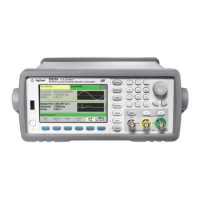FUNCtion Subsystem
[SOURce[1|2]:]FUNCtion <function>
[SOURce[1|2]:]FUNCtion?
Selects output function.
Parameter Typical Return
{SINusoid|SQUare|TRIangle|RAMP|PULSe|PRBS|NOISe|ARB|DC},defaultSINusoid SIN, SQU, TRI, RAMP, PULS,
PRBS, NOIS, ARB, or DC
Set output on channel 2 to sine:
SOUR2:FUNC SIN
l The selected waveform (other than an arbitrary waveform) is output using the previously selected frequency,
amplitude, and offset voltage settings. Arbitrary waveforms are played according to the settings specified in the
arbitrary waveform file. Brand new arbitrary waveforms inherit the current arbitrary waveform settings.
l NOISe generates white gaussian noise with adjustable bandwidth and Crest Factor about 3.5.
l PRBS generates pseudo-random noise using Linear Feedback Shift Register (LFSR) user selectable methods.
l ARB generates the arbitrary waveform currently selected by FUNCtion:ARBitrary.
l Function Limitations: If you change to a function whose maximum frequency is less than that of the current func-
tion, the frequency is adjusted to the maximum for the new function. For example, if you change a high frequency
sine wave to the ramp function, the instrument will adjust the output frequency to 200 kHz (the upper limit for
ramps)From the remote interface, a "Settings conflict" error will also be generated.d.
l Amplitude Limitations: If you change to a function whose maximum amplitude is less than that of the current
function, the amplitude is adjusted to the maximum for the new function. This may occur when the output units
are Vrms or dBm due to the differences in crest factor for the various output functions For example, if you change
a 5 Vrms square wave (into 50 Ω) to a sine wave, the instrument will adjust the amplitude to 3.536 Vrms (the
upper limit for sine in Vrms). The remote interface will also generate a "Settings conflict" error.
[SOURce[1|2]:]FUNCtion:ARBitrary {<filename>}
[SOURce[1|2]:]FUNCtion:ARBitrary?
Selects an arbitrary waveform (.arb/.barb) or sequence (.seq) that has previously been loaded into volatile memory for
the channel specified with MMEMory:LOAD:DATA[1|2] or DATA:ARBitrary. Several waveforms can be in volatile mem-
ory simultaneously.
Parameter Typical Return
See MMEMory:LOAD:DATA[1|2], for valid <filename> formats. "INT:\MyArb103.arb"
Select an arbitrary waveform in memory on channel 2:
FUNC:ARB "INT:\MyArb103.arb"
l The <filename> should match the filename used to load the arbitrary waveform or sequence into volatile memory
with MMEMory:LOAD:DATA[1|2], DATA:ARBitrary, DATA:ARBitrary:DAC, or DATA:SEQuence.
l When you store an arbitrary waveform segment or sequence (MMEMory:STORe:DATA[1|2]), the instrument's cur-
rent settings (voltage values, sample rate, filter type, and so on) are stored in the segment or sequence file. When
you play the file for the first time with FUNCtion:ARBitrary, these settings are loaded and override the
212 Agilent 33500 Series Operating and Service Guide

